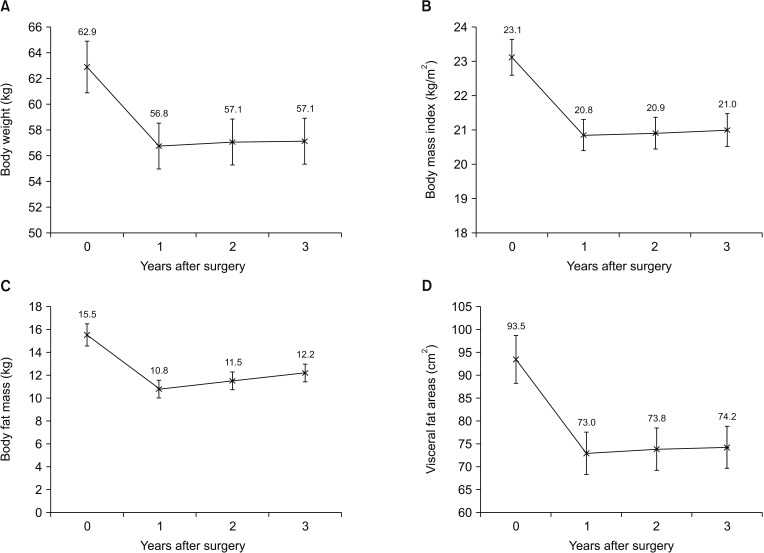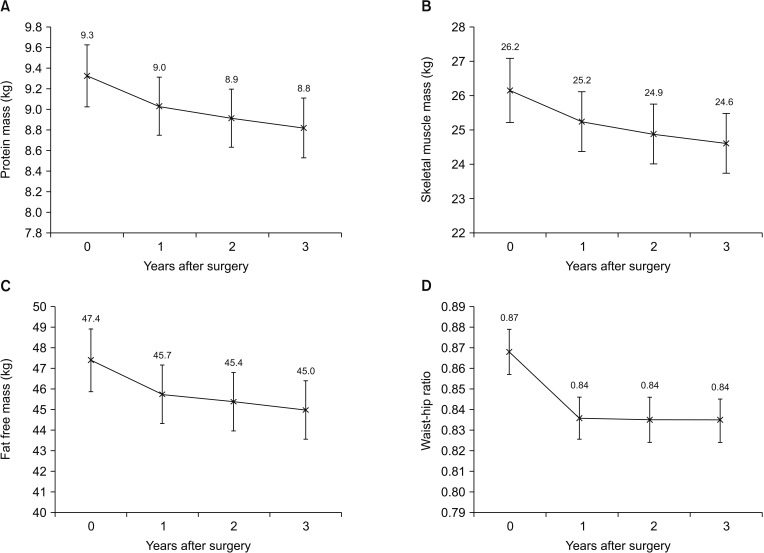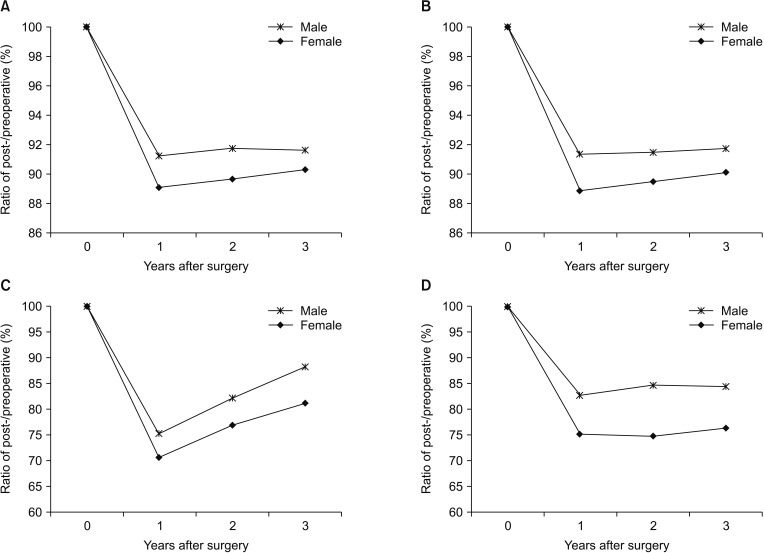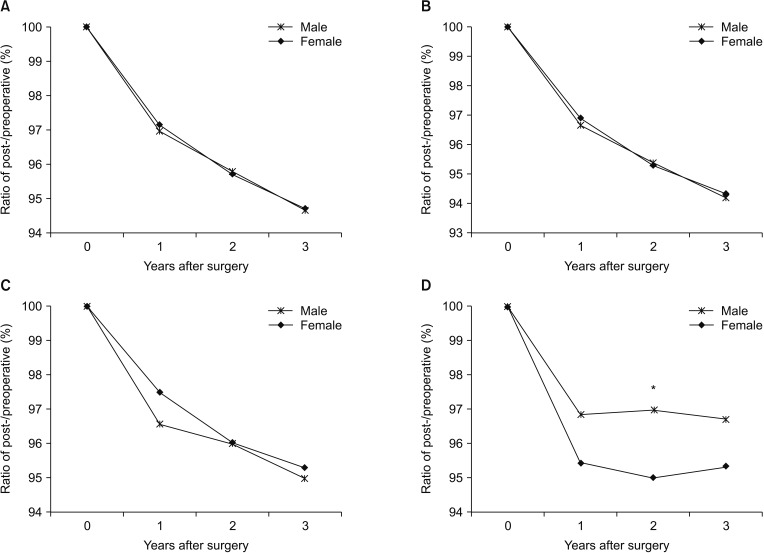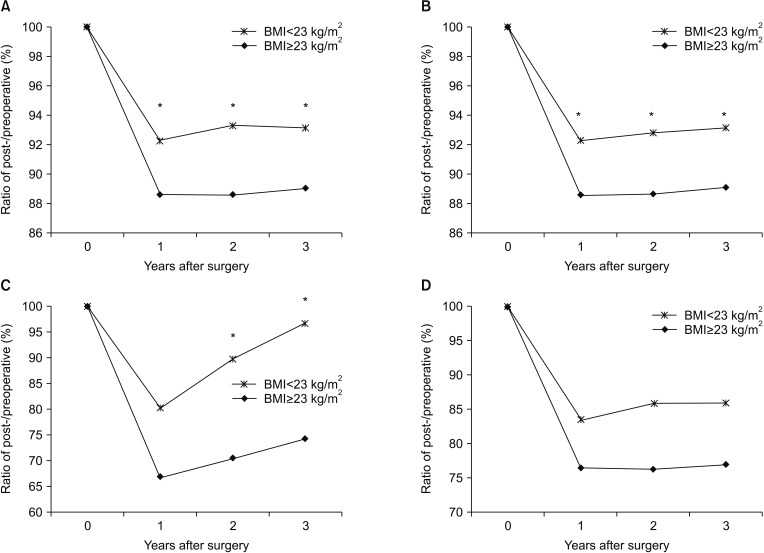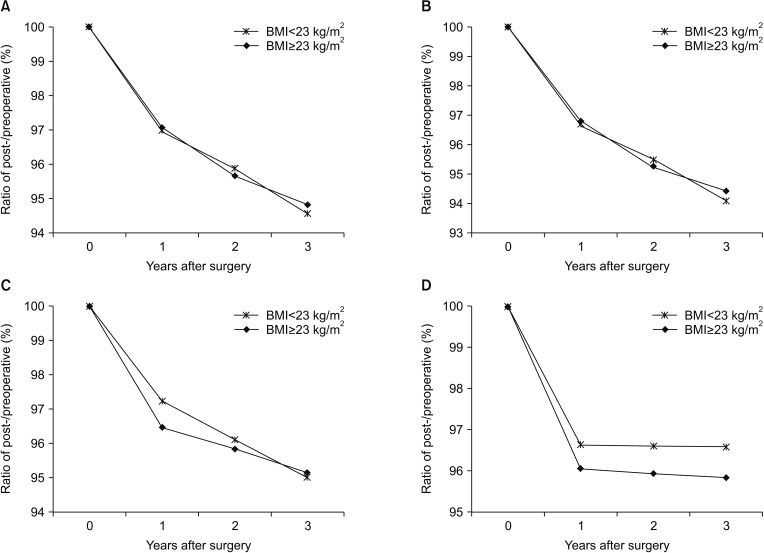Ann Surg Treat Res.
2018 Oct;95(4):192-200. 10.4174/astr.2018.95.4.192.
Midterm body composition changes after open distal gastrectomy for early gastric cancer
- Affiliations
-
- 1Gastric Cancer Center, Kyungpook National University Chilgok Hospital, Daegu, Korea. wyu@knu.ac.kr
- KMID: 2421197
- DOI: http://doi.org/10.4174/astr.2018.95.4.192
Abstract
- PURPOSE
This study evaluated midterm changes in body composition after open distal gastrectomy for early gastric cancer.
METHODS
Data from 138 gastric cancer patients who underwent open distal gastrectomy at Kyungpook National University Chilgok Hospital between January 2011 and December 2012 were collected and reviewed. Patients with pathological stage I gastric cancer and with no comorbidities at diagnosis were enrolled. Body composition data from segmental multifrequency bioelectrical impedance analysis were obtained preoperatively and at 1, 2, and 3 years after surgery.
RESULTS
The mean body weight losses at 1 and 3 years after surgery were 6.1 kg and 5.8 kg, respectively (P < 0.001). The protein mass, skeletal muscle mass, and fat-free mass decreased continuously until 3 years after surgery (0.5 kg, 1.6 kg, and 2.4 kg, respectively; P < 0.001). The average body fat mass and visceral fat area loss at 1 year after surgery were 4.7 kg and 20.5 cm2, respectively (P < 0.001). After 1 postoperative year, the body fat mass and visceral fat areas increased continuously, up to 12.2 kg and 74.2 cm2 at 3 years after surgery, respectively (+1.4 kg and +1.2 cm2, respectively).
CONCLUSION
More intense nutritional and exercise programs may be important after gastric cancer surgery, especially during the first postoperative year.
Keyword
MeSH Terms
Figure
Cited by 1 articles
-
Chronological changes in quality of life and body composition after gastrectomy for locally advanced gastric cancer
Ki Bum Park, Ji Yeon Park, Seung Soo Lee, Ho Young Chung, Oh Kyoung Kwon
Ann Surg Treat Res. 2020;98(5):262-269. doi: 10.4174/astr.2020.98.5.262.
Reference
-
1. Armbrecht U, Lundell L, Lindstedt G, Stockbruegger RW. Causes of malabsorption after total gastrectomy with Roux-en-Y reconstruction. Acta Chir Scand. 1988; 154:37–41. PMID: 3354282.2. Adams JF. The clinical and metabolic consequences of total gastrectomy. I. Morbidity, weight, and nutrition. Scand J Gastroenterol. 1967; 2:137–149. PMID: 20184481.3. Katsube T, Konnno S, Murayama M, Kuhara K, Sagawa M, Yoshimatsu K, et al. Changes of nutritional status after distal gastrectomy in patients with gastric cancer. Hepatogastroenterology. 2008; 55:1864–1867. PMID: 19102410.4. Lorenzo AD, Andreoli A. Segmental bioelectrical impedance analysis. Curr Opin Clin Nutr Metab Care. 2003; 6:551–555. PMID: 12913672.
Article5. Jaffrin MY, Morel H. Body fluid volumes measurements by impedance: a review of bioimpedance spectroscopy (BIS) and bioimpedance analysis (BIA) methods. Med Eng Phys. 2008; 30:1257–1269. PMID: 18676172.
Article6. Heymsfield SB, Lichtman S, Baumgartner RN, Wang J, Kamen Y, Aliprantis A, et al. Body composition of humans: comparison of two improved four- compartment models that differ in expense, technical complexity, and radiation exposure. Am J Clin Nutr. 1990; 52:52–58. PMID: 2360552.7. Brodie D, Moscrip V, Hutcheon R. Body composition measurement: a review of hydrodensitometry, anthropometry, and impedance methods. Nutrition. 1998; 14:296–310. PMID: 9583375.
Article8. Bioelectrical impedance analysis in body composition measurement: National Institutes of Health Technology Assessment Conference Statement. Am J Clin Nutr. 1996; 64(3 Suppl):524S–532S. PMID: 8780375.9. De Lorenzo A, Andreoli A, Matthie J, Withers P. Predicting body cell mass with bioimpedance by using theoretical methods: a technological review. J Appl Physiol (1985). 1997; 82:1542–1558. PMID: 9134904.
Article10. Kiyama T, Mizutani T, Okuda T, Fujita I, Tokunaga A, Tajiri T, et al. Postoperative changes in body composition after gastrectomy. J Gastrointest Surg. 2005; 9:313–319. PMID: 15749590.
Article11. Liedman B, Andersson H, Bosaeus I, Hugosson I, Lundell L. Changes in body composition after gastrectomy: results of a controlled, prospective clinical trial. World J Surg. 1997; 21:416–420. PMID: 9143575.
Article12. Abdiev S, Kodera Y, Fujiwara M, Koike M, Nakayama G, Ohashi N, et al. Nutritional recovery after open and laparoscopic gastrectomies. Gastric Cancer. 2011; 14:144–149. PMID: 21327442.
Article13. Park KB, Kwon OK, Yu W, Jang BC. Body composition changes after totally laparoscopic distal gastrectomy with delta-shaped anastomosis: a omparison with conventional Billroth I anastomosis. Surg Endosc. 2016; 30:4286–4293. PMID: 26823058.14. Hwang SE, Kim CY, Yang DH. Changes in body composition after a radical gastrectomy for a gastric adenocarcinoma using bioelectrical impedance analysis during the first year following surgery. J Korean Gastric Cancer Assoc. 2007; 7:228–236.
Article15. Leibel RL, Rosenbaum M, Hirsch J. Changes in energy expenditure resulting from altered body weight. N Engl J Med. 1995; 332:621–628. PMID: 7632212.
Article16. Weyer C, Pratley RE, Salbe AD, Bogardus C, Ravussin E, Tataranni PA. Energy expenditure, fat oxidation, and body weight regulation: a study of metabolic adaptation to long-term weight change. J Clin Endocrinol Metab. 2000; 85:1087–1094. PMID: 10720044.17. Iivonen MK, Ahola TO, Matikainen MJ. Bacterial overgrowth, intestinal transit, and nutrition after total gastrectomy. Comparison of a jejunal pouch with Rouxen-Y reconstruction in a prospective random study. Scand J Gastroenterol. 1998; 33:63–70. PMID: 9489910.18. Murawa D, Murawa P, Oszkinis G, Biczysko W. Long-term consequences of total gastrectomy: quality of life, nutritional status, bacterial overgrowth and adaptive changes in esophagojejunostomic mucosa. Tumori. 2006; 92:26–33. PMID: 16683381.
Article19. Bragelmann R, Armbrecht U, Rosemeyer D, Schneider B, Zilly W, Stockbrugger RW. Nutrient malassimilation following total gastrectomy. Scand J Gastroenterol Suppl. 1996; 218:26–33. PMID: 8865447.20. Saito A, Noguchi Y, Yoshikawa T, Doi C, Fukuzawa K, Matsumoto A, et al. Gastrectomized patients are in a state of chronic protein malnutrition analyses of 23 amino acids. Hepatogastroenterology. 2001; 48:585–589. PMID: 11379360.21. Tershakovec AM, Kuppler KM, Zemel B, Stallings VA. Age, sex, ethnicity, body composition, and resting energy expenditure of obese African American and white children and adolescents. Am J Clin Nutr. 2002; 75:867–871. PMID: 11976160.
Article22. Paul DR, Novotny JA, Rumpler WV. Effects of the interaction of sex and food intake on the relation between energy expenditure and body composition. Am J Clin Nutr. 2004; 79:385–389. PMID: 14985211.
Article23. WHO Expert Consultation. Appropriate body-mass index for Asian populations and its implications for policy and intervention strategies. Lancet. 2004; 363:157–163. PMID: 14726171.24. Kim H, Suh EE, Lee HJ, Yang HK. The effects of patient participation-based dietary intervention on nutritional and functional status for patients with gastrectomy: a randomized controlled trial. Cancer Nurs. 2014; 37:E10–E20. PMID: 23632471.
- Full Text Links
- Actions
-
Cited
- CITED
-
- Close
- Share
- Similar articles
-
- Laparoscopic Distal Gastrectomy for Gastric Cancer
- The Effects of Obesity on Laparoscopy-Assisted Distal Gastrectomy and Conventional Open Gastrectomy in Patients with Early Gastric Cancer
- Body Compositions of Elderly and Non-Elderly Patients Following Gastrectomy for Gastric Cancer
- Laparoscopy-Assisted Distal Gastrectomy for Early Gastric Cancer in the Elderly
- Larger Remaining Stomach Volume Is Associated With Better Nutrition and Muscle Preservation in Patients With Gastric Cancer Receiving Distal Gastrectomy With Gastroduodenostomy

